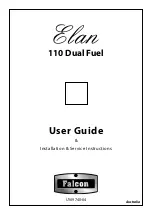
For cooking on solid disk
elements, the use of appropriate
cookware is very important.
●
Aluminum cookware conducts
heat faster than other metals,
●
Cast iron and coated cast iron
containers are slow to absorb heat,
but generally cook evenly at
minimum or medium heat settings.
●
Glass cookware should be used
as the manufacturer describes.
. Do not use a wire trivet or any
other kind of heat-retarding pad
between the cookware and the
element.
●
Good pans have a thick, flat
bottom which absorbs the heat from
the element. The thick, flat bottom
provides good heat distribution
from the element to the food. This
cooking process requires little
water, fat or electricity.
●
Pans with thin, uneven bottoms
do not adequately utilize the heat
coming from the element. The food
to be cooked may burn and require
more time and electricity. You
would also have to add more fat or
water.
with uneven bottoms are not
. Don’t use pans with rounded
bottoms. They don’t have enough
contact with the solid disk element
to cook properly.
●
Use pans of the correct diameter
They should be slightly larger
than the solid disk element so
will flow onto the
and not bake onto the
A damp cloth is sufficient
to remove the spill. Pans should not
overhang more than 1 inch beyond
the element.
●
To optimize cooking time and
energy usage, you should use a
pan that is sized correctly for the
cooking process, with a well-fitted
●
Place only dry pans on the solid
disk element. Do not place lids on
the element, particularly wet lids.
●
Some special cooking procedures
require specific cookware such as
pressure cookers, deep fat fryers,
etc., All cookware must have flat
bottoms and be the
size. The
cookware should
be covered,
if applicable to the cooking process.
. Except in pressure cooking
with water and water bath canning,
canning pots
not extend
than 1 inch beyond the surface a
solid disk element and should have
flat bottoms.
canning pots do
not meet this description, the use of
lid to avoid evaporation loss, and
the maximum heat
causes
cook with as
water or fat as
excessive heat buildup and may
possible. If the pan is too small,
result in damage to the
energy is wasted and spillage can
See “Home Canning Tips” on
flow onto the solid disk element.
page 10 for further information.
check how a pan
perform on a
1.
1 inch of water into the pan.
confirms a good heat transfer and
2. Bring water to a boil and
a good pot.
observe the pattern of the
4. Bubbles localized in
a
bubbles as the water comes to
portion of the bottom indicate
a boil.
uneven contact of the pan to the
3. A uniform pattern of bubbles
element, uneven heat transfer,
across the
of the pan
and an unsuitable pot.
7
Содержание JP330L
Страница 14: ...Noks 14 ...


































